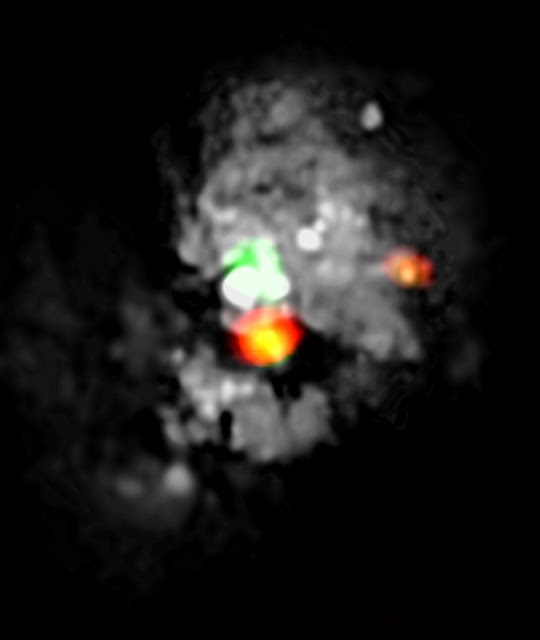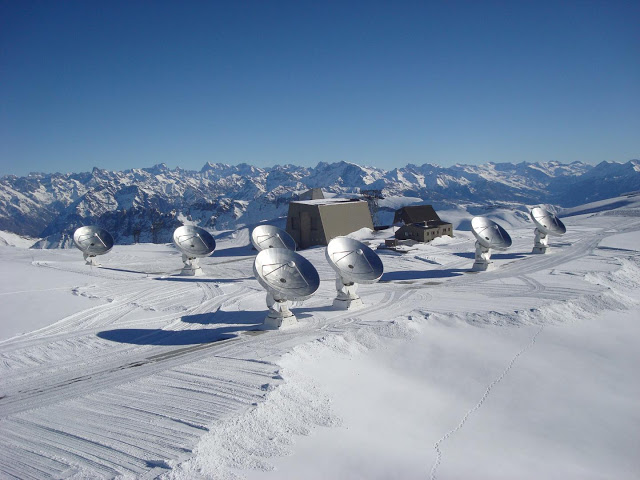| Online: | |
| Visits: | |
| Stories: |

| Story Views | |
| Now: | |
| Last Hour: | |
| Last 24 Hours: | |
| Total: | |
The ‘Eye Of Medusa’ – Unknown Extreme Star Formation Discovered

Credit: IRAM – Institut de Radioastronomie Millimetrique
Other observatories have previously mapped the Medusa merger but none had detected the existence of this region of high-density gas in the ‘Eye’ until now. The new discovery has not only proven its existence, but also has implications for our understanding of the origins of the Universe and will influence future investigative techniques.
Previous exploration of the Medusa merger had involved carbon monoxide (CO) – the most common molecule used in radio observations at millimeter wavelengths.
Observations of this molecule had never before revealed any detail of a potential ‘Eye’ region. The IRAM team, led by Sabine Koenig, tried a new way in, tuning the NOEMA antennas to detect hydrogen cyanide (HCN) and formylium (HCO+) molecules.
The discovery demonstrates that star development can be probed in stages of formation, which are currently not detectable by tracing carbon monoxide. By successfully detecting other molecules, the extreme star formation observed in the ‘Eye’ demonstrates the existence of more complex chemical formulations than previously thought. This discovery means our understanding of the chemical formation of stars can be hugely expanded upon.
Studies on galaxy collisions and their impact on star formation are fundamental to understanding how galaxies have assembled throughout the history of the Universe.
Sabine Koenig of IRAM, who led the team of researchers in the discovery, said, “It was a great surprise to see this region brightly illuminated all of a sudden, and see it shine with the light of thousands of recently formed stars. This region turns out to be the site of the most extreme stellar nursery in this galactic collision!”
Roberto Neri, Scientific Director of the NOEMA observatory, said, “These observations clearly show that we have perfectly mastered the new instrument and that NOEMA will allow us to uncover and explore the complex process of star formation in the most hidden places of our Universe in the coming years”.
NOEMA is the result of an international effort and will operate in synergy with the largest and most important astronomical instruments on Earth and in space. It can probe the cold universe (around -250 degrees Celsius) and detect the cold interstellar matter (gas and dust), which is responsible for the formation of new stars and planets. It is part of a new generation of radio telescopes employing the most advanced technologies available. Although still under construction, this instrument is already the most powerful millimeter wave interferometer in the Northern Hemisphere.
NOEMA — the most powerful millimeter radio telescope of the Northern Hemisphere, is located in the French Hautes-Alpes on the Plateau de Bure.

Credit: IRAM/André Rambaud
NOEMA will be one of the leading instruments in the hunt for astronomical discoveries in the most remote regions of our Universe and its capabilities will ultimately contribute to human understanding of the evolution of the universe.
Contacts and sources:
Fareha Lasker
Source:





It’s funny how people accept pictures. or animation video
 Monkeys
Monkeys  than god dont
than god dont 



By: Nasa BAD Video Pic Fake invasion Wake Up
If nasa = in space than god dont
Warns we are living in very, Dangerous time in human history
FAKE NEWS INVASION